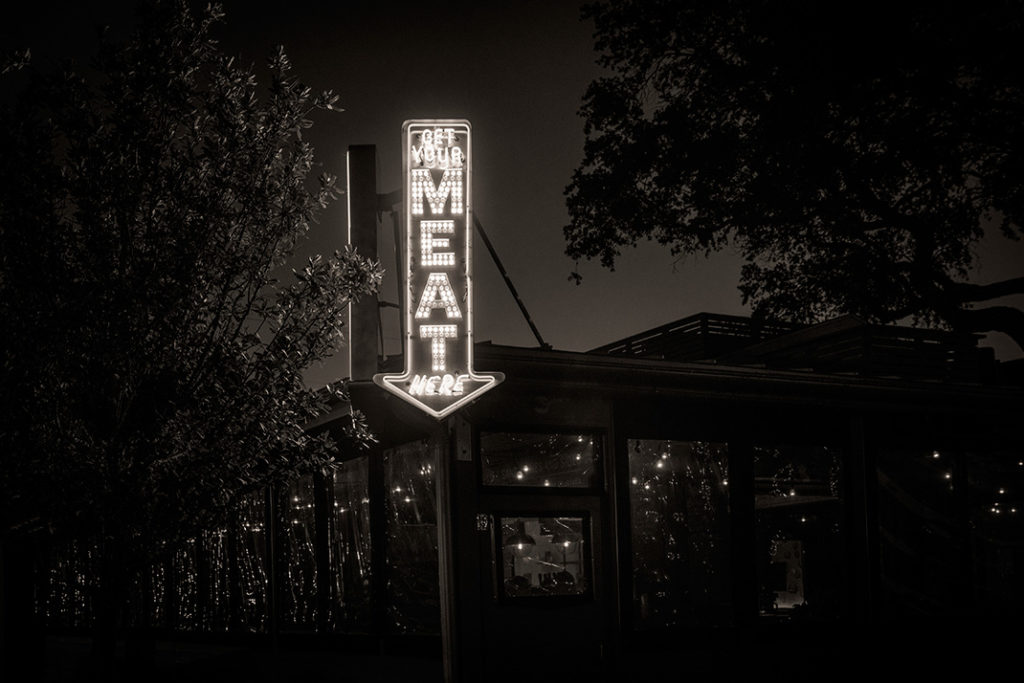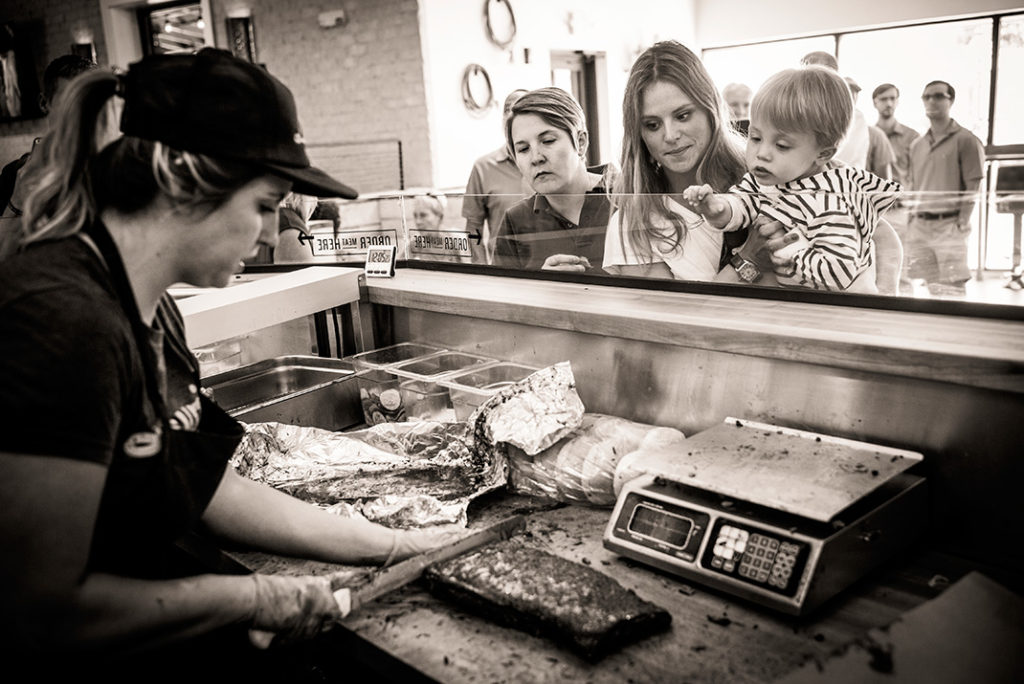
The pit fires burn at Lewis Barbecue in Charleston, South Carolina. (Photo ©Darren Carroll)
Barbecue maestro John Lewis manages a staff of 60 at his restaurant — Lewis Barbecue — in Charleston, S.C.
“Yeh, it’s a big place,” he said recently. “We’re open 11 hours a day. Sometimes it’s crisis central. Most of the time it’s just management.”
In the world of smoked meat, the term “legend” sometimes gets tossed around too easily. John Lewis, though, legitimately deserves the tag. In Austin, he assisted Aaron Franklin back in Franklin Barbecue’s embryonic trailer days. And Lewis later helped make la Barbecue one of the best joints in the state.
Now, as a restaurant owner and entrepreneur, Lewis spends much less time cooking and much more time managing his businesses and greeting customers. He has opened a Tex-Mex place called Juan Luis in a food court. It uses leftovers — brisket and pork — from Lewis Barbecue.
“In hospitality, waste is always an issue that you’re trying to keep track of if you want to run a successful business,” Lewis said. “Or else you’re just throwing money away.”
Another food concept Lewis said he has experimented with is French-themed, called Jean Louis.
Love the multi-lingual takes on his name.

The neon lights beckon diners to Lewis Barbecue. (Photo ©Darren Carroll)
All in all, Lewis seems very happy in South Carolina.
“I think it was the best place I could have moved, especially Charleston,” he said. “It has a national reputation. If you do something good here, everybody is going to hear about it.”
Lewis Barbecue opened in 2016 and Eater Charleston named it the Restaurant of the Year. Posse members Libby and Mike Gagne visited that year and gave the place high reviews. Last year, Thrillist included Lewis Barbecue on its list of the 33 best joints in America and John Lewis cooked on a snow covered lot in Brooklyn for an appearance on CBS This Morning.

Photographer Darren Carroll at Louie Mueller Barbecue, Taylor, Texas, 2009. (Photo ©Brad Mangin)
Before we get too far along with the words to this story, however, we have to talk about the wonderful photos that accompany it. They were made by commercial photographer and barbecue aficionado Darren Carroll. Truth be told, the story is accompanying the photos, not the other way around. Words and pictures. Pictures and words. Great combination, just like brisket and ribs.
Carroll said his shoot resulted from some serendipity of timing and flight scheduling that left him with a free day in Charleston. On his way to a wedding reception there, he emailed John Lewis during a flight layover asking if he could stop by, talk and maybe take some photos. By the time he landed in the Holy City that night, Lewis had responded: "Sure, come on by."
Carroll did. For lunch he had the El Sancho Loco sandwich -- brisket, pulled pork and hot guts. "It was amazing," Carroll said. Afterward, he spent about an hour talking with Lewis and others. Before he left, he said, he brought up the idea of coming back and spending most of a day at the joint. His idea was to get a photo package that he could pitch to magazines.
A month later, he arrived at Lewis Barbecue at about 4 a.m. and documented much of a day-in-the-life of the place. While Carroll said he got some nibbles for the photo package from magazines, there were no takers. "I’m really happy the Posse can give some of these pictures a home," he said. So are we. Thank you, Darren Carroll!

Lighting the pit fires at 4 a.m. (Photo ©Darren Carroll)
The Posse's recent conversation with John Lewis took place by phone one morning while he was going to the airport for a flight to Chicago. A long-time fan of the Kinks, he was on his way to see a concert by a semi-reconstitution of the old group.
Yes, Lewis said, the music of the Kinks played in steady rotation many of those long nights he was becoming a well respected barbecue man about town working the pits at Franklin and la Barbecue.
While personable and friendly, John Lewis doesn’t reveal too many of his secrets for success. Precise recipes or unusual ingredients? Not saying. Specific techniques to enhance taste? Nope.
One concession: “Anyone telling you they are using just salt and pepper for seasoning, it’s b.s.,” he said.
John Lewis admits that through trial and error on the barbecue competition circuit he learned some “finishing touches” that he uses at his restaurant.
Any specifics?
“A few secrets that happen once the meat comes off the pit,” he allowed, unspecifically. “I wouldn’t have learned that if it hadn’t been for competitions.”
(Note: Years ago, the Posse’s Marshall Cooper cooked with Lewis at competitions.)

John Lewis in front of one of his hand-made pits. (Photo ©Darren Carroll)
In interview after interview over the years, Lewis has emphasized the importance of cooking on a good pit. The machine is almost more important than the person using it.
He built the four main, 1,000-gallon, pits in use at Lewis Barbecue, as well as the sausage cooker and two back-up pits. Because of their design, they provide optimum control of temperature and smoke levels, Lewis said, minimizing the need to rotate or move the meat around during the cook. He doesn’t wrap until the finished meat is coming off the pit.
Lewis added that he is getting ready to build six more pits.
So you’re expanding? I asked.
He didn’t answer out loud, but I was pretty sure there was a coy smile at the other end of the wireless connection.
As you can tell from the size of the workforce at Lewis Barbecue, it’s long hours of operation, including a full bar, the place does big business.
Lewis said his joint receives and uses about two tons of brisket a week. And none of it is wasted. Some of the meat and fat trimmings go into his homemade sausage. The rest of the fat is rendered.
“We don’t buy oil anymore,” he said. “We cook with all-beef tallow.
“It’s how McDonald’s cooked its fries in the old days,” he explained. “Ninety-three percent beef tallow.”
Those were damn good fries. And John Lewis produces damn good barbecue.
Lewis Barbecue, 464 N Nassau St, Charleston, SC, 843-805-9500. Open Tues-Sun 11am-10pm.

Prepping the beef ribs at Lewis Barbecue. (Photo ©Darren Carroll)

Time for the rub as meat is prepped. (Photo ©Darren Carroll)

Loading the pits at Lewis Barbecue. (Photo ©Darren Carroll)

John Lewis leads a menu-tasting session in the smokehouse of his restaurant. (Photo ©Darren Carroll)

Lewis Barbecue's smokehouse holds four enormous, hand-made pits. (Photo ©Darren Carroll)

John Lewis uses meat cleavers as damper handles on his hand-made pits; this one belonged to his grandfather. (Photo ©Darren Carroll)

Lewis Barbecue receives a wood delivery to feed its pits. (Photo ©Darren Carroll)

Briskets are trimmed at Lewis Barbecue. (Photo ©Darren Carroll)

Chicken wings coming off the pit. (Photo ©Darren Carroll)

A few words of advice on the way in at Lewis Barbecue, SC. (Photo ©Darren Carroll)

Would you like any sides with that? (Photo ©Darren Carroll)

Main dining room at Lewis Barbecue. (Photo ©Darren Carroll)

The Lewis Barbecue staff puts together an order. (Photo ©Darren Carroll)

The main attraction, amazing brisket at Lewis Barbecue. (Photo ©Darren Carroll)

Get 'em started early, I say. (Photo ©Darren Carroll)







